
By Casey Smith, Naturalist
I’ve decided that 2019 is the year I become really good at crochet. This means I’ve been obsessed with finding cool patterns, learning cool new stitches, and buying yarn. I’m not sure how many of you have bought good yarn, but it’s expensive! I’m also trying to reduce the amount of plastic I use. So, if you are trying to be an environmentally friendly fiber crafter like me, you want to stay away from the cheaper acrylic or synthetic yarns. Things made of synthetic yarns shed tiny fibers called microfibers or microplastics. This shedding occurs most often when the items are washed. A study done in 2011 found that when washed, clothes made from synthetic materials could release up to 1,900 microfibers! These microfibers get through the drain and into our waterways, eventually making their way to the ocean. These tiny fibers take a LONG time to biodegrade and are contributing to the growing problem of plastics in the ocean.
This doesn’t mean we need to give up our affordable yarns for good. You can still use synthetic yarns for items that don’t get washed often, like a basket or a scarf. If you do need to wash synthetic fibers, you can wash the items in a bag designed to trap the microfibers.
There’s now a growing trend in recycled yarn. People are buying sweaters at thrift stores or from charities, unravelling the sweater, washing the yarn, then using it to make new pieces. Some people are even selling this yarn on sites like Etsy. This can be a way to buy those normally expensive wool, alpaca, cashmere, or even silk fibers at a more affordable price. Now that I know about these recycled yarns, and the microfibers that synthetics release, I’m going to commit to using only natural or recycled yarn.
 So, what can you do? Even if you’re not obsessing over environmentally friendly yarn, you can still choose to purchase clothes and accessories made from natural materials and stay away from synthetics. The most common synthetic fibers are Polyester, Nylon, Acrylic, Rayon, Fleece, and Microfleece. Instead, opt for clothes made from Cotton, Hemp, Linen, Jute, Wool, or Silk. Making these and other little changes in your life can make a difference in the amount of plastics getting into our waterways.
So, what can you do? Even if you’re not obsessing over environmentally friendly yarn, you can still choose to purchase clothes and accessories made from natural materials and stay away from synthetics. The most common synthetic fibers are Polyester, Nylon, Acrylic, Rayon, Fleece, and Microfleece. Instead, opt for clothes made from Cotton, Hemp, Linen, Jute, Wool, or Silk. Making these and other little changes in your life can make a difference in the amount of plastics getting into our waterways.






